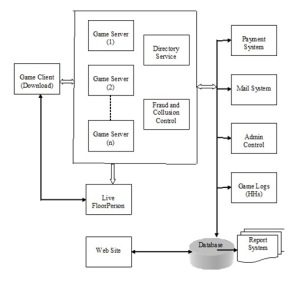It is so much fun playing poker online on your laptop or your desktop within the relaxed atmosphere of your home, it also is good learning to understand a little bit how they make it work. Every online gaming company builds its software within a planned system structure.
The poker software architecture of a program or computing system is the structure or structures of the system, which comprise software components, the externally visible properties of those components, and the relationships between them.
For laymen like us, I thought that it might be difficult understanding what poker architecture actually entails, so when I joined Cybertech, I spent quite a few days with our company programmers and got a lot of inputs from them. I found that once I understood the basics, it was pretty interesting how our programmers plan, design and monitor the system poker architecture for the poker games that our company builds.
Poker architecture is designed by our programmers with the following goals:
a. Bug-free and high speed game play, providing a great play experience to the user.
b. Dynamic scalability, wherein augmenting the capability of the system without disturbing the already running components of the systems.
c. Dynamic configuration, wherein the behavior of the system should be able to re-configure dynamically.
d. Availability of games and services all the time by having redundancies and backups for each and every sub-system.
e. Simultaneous multiple games, where the user should be able to play multiple games simultaneously.
f. Varied types of games, like holdem, Omaha, Omaha hi/lo, 7 stud, 7 stud hi/lo, heads-up, single and multi table tournaments, no-limit, pot-limit etc.,
g. Persistence of the Game, in case of unintended disconnection, the client should be able to reconnect to the game(s) within 30 seconds. If he connects, he should be able to continue from the point where he left.
h. Transparent and seamless Payment system integration, to spare user from knowing the Payment system account.
A high level System Poker architecture includes the following major sub-systems:
1. Game Client (Download)
2. Game Server(s)
3. Directory Service
4. Database
5. Payment system
6. Mail System
7. Report System
8. Live Floor Person
9. Admin Control
10. Fraud and Collusion Control.
11. Game Logs
A complete and comprehensive security system including a system for prevention of DDoS attacks is an imperative as well. The following diagram I’ve inserted sort of depicts the high level diagram of a typical Poker architecture System:

Fig.1 Poker Architecture
In my dealings with customers for our company products, I am often asked what architecture or platforms our poker products are built on and support, and after regular meetings with our software programmers, I can today safely say that I can answer quite a few queries without batting an eyelid. Since I cannot make this a long winded post and bore my readers with lots of technicalities, I’d like to end by stating that the right poker architecture is the basic building block of the entire software suite which takes years to build.
With the right poker architecture, you’re halfway home 🙂
This Blog has a lot to offer in a Crux .
To name a few , the complete system of the Poker Software holds to , playing in a highly protected online environment , takes care of the servers which can even damage the root of the software .
It even talks of all the sytems on how Poker Architecture works in a online gaming industry.
After reading the blog you come to know all the possibilities of what Poker has to offer as a fun and exhilarating platform .